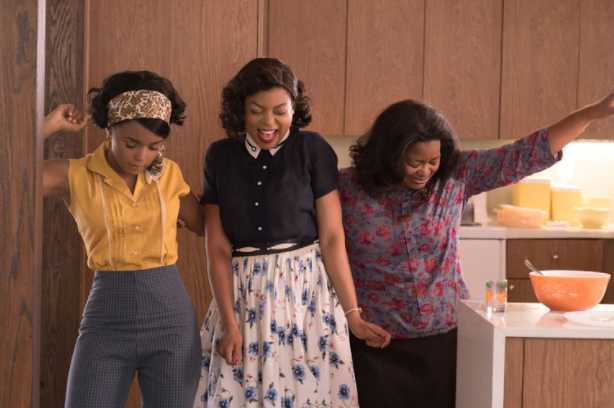A film about a trio of exceptionally brilliant black female mathematicians, one would think, ought to be directed by, ideally, a black female–or at least a female. But Hidden Figures falls slightly short in this regard by enlisting St. Vincent director Theodore Melfi for the job. As the other movie it somehow gets conflated with, Fences (a.k.a. Hidden Fences), utilized a black voice in the form of Denzel Washington to adapt and direct August Wilson’s explosive play, so too, should it have been the case for adapting Margot Lee Shetterly’s historical novel. At least the screenplay was co-written by a woman though–and Mean Girls 2 writer Allison Schroeder no less.
From the very first scene, Hidden Figures establishes one of the many day-to-day struggles of co-workers and friends Katherine Goble (Taraji P. Henson), Dorothy Vaughan (Octavia Spencer) and Mary Jackson (Janelle Monae, who continues to prove her acting abilities post-Moonlight) as they ride to NASA headquarters in Hampton, Virginia–a state quite fond of Jim Crow laws (as another recent historical film, Loving, reminds us), particularly in 1961. As Dorothy tinkers underneath the car, Mary, the sauciest of them, and Katherine dread an oncoming police car. While Dorothy and Katherine try to act reassuring, Mary knows all too well that they’re going to have to explain a situation that no white person would have to justify: the basic misfortune of having car trouble. After the police officer unsurprisingly bristles and balks at their explanation of running late to NASA, he offers to give them an escort that allows Mary the thrill of chasing a white piggy down the highway at an illegal speed limit.
And it is with this scene, both an exhibition of racism rendered with a comedic tinge, that Hidden Figures manages to bring the “feel-good” genre to a topic that has elsewhere been held up to the silver screen with a far less triumphant light (barring, of course, another Octavia Spencer vehicle, The Help, which was discounted for defaulting to the white savior archetype).
“That’s just how it is” is a term that gets thrown a lot throughout the film, designed to discourage Mary from attempting to pursue a career as an engineer, Katherine from simply performing the tasks of her job and Dorothy from being given the title of supervisor that she rightly deserves. And yet, the more someone tells you that you can’t have or do something, the more you want to disprove it and throw it back in their face. It is for this reason–in addition to the obvious fact that they’re all far more capable than their white male superiors–that each woman prevails in her own way. All while executing complex mathematical equations, Katherine runs back and forth to the “colored” bathroom roughly three times a day (a round trip of forty minutes on foot) until she finally breaks down screaming at director of the Space Task Group Al Harrison (Kevin Costner) when he questions why she’s always gone when he needs her. Elsewhere, Mary petitions the court to take the classes at an all-white school necessary to complete the requirements for applying as an engineer and Dorothy kifes a library book about the language of the IBM 7090 being installed in their building to get ahead of the curve when the computer inevitably replaces her and her team’s jobs.
And yet, through all the strife and the awareness of the succinct notion that “every time we get a chance to get ahead, they move the finish line,” there is an undercurrent of comedy. Because if you can’t laugh to keep from crying, then how can you be expected to get through anything? This is what makes Hidden Figures one of the most unique films about a black historical moment in time–it doesn’t pander to pity or guilt, but iterates that enough persistence can help one rise above in even the most stifling of circumstances.





















